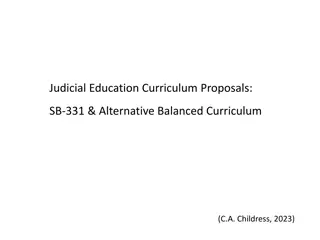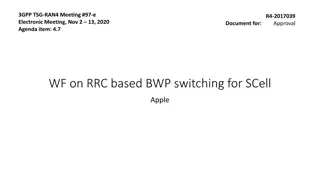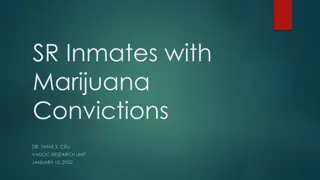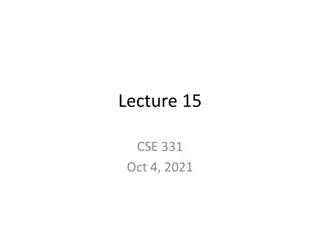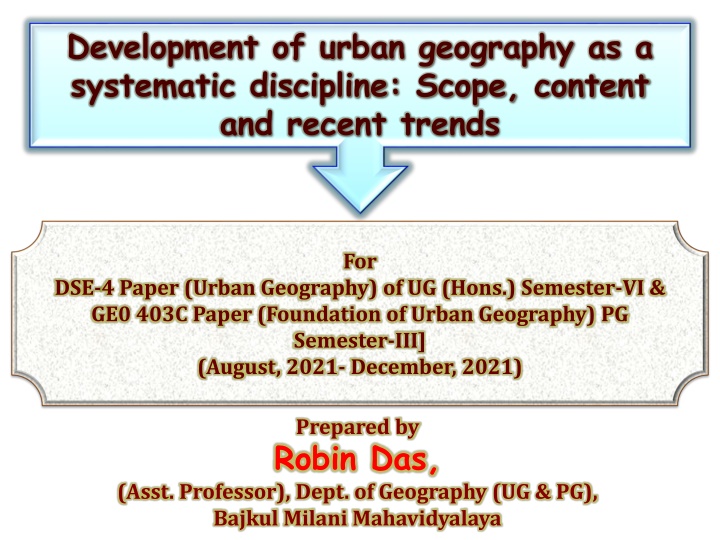
Evolution of Urban Geography as a Systematic Discipline
Urban geography is a subdiscipline focused on studying cities, urban processes, and their impact on social and physical structures. This discipline examines aspects of urban life, governance, infrastructure, and socio-spatial dynamics. The history of urban geography traces back to ancient times, with early emphasis on city location, structure, and economic roles. Over the years, urban geography has evolved to encompass a systematic approach to understanding urban environments and their complexities.
Download Presentation

Please find below an Image/Link to download the presentation.
The content on the website is provided AS IS for your information and personal use only. It may not be sold, licensed, or shared on other websites without obtaining consent from the author. If you encounter any issues during the download, it is possible that the publisher has removed the file from their server.
You are allowed to download the files provided on this website for personal or commercial use, subject to the condition that they are used lawfully. All files are the property of their respective owners.
The content on the website is provided AS IS for your information and personal use only. It may not be sold, licensed, or shared on other websites without obtaining consent from the author.
E N D
Presentation Transcript
Development of urban geography as a systematic discipline: Scope, content and recent trends For DSE-4 Paper (Urban Geography) of UG (Hons.) Semester-VI & GE0 403C Paper (Foundation of Urban Geography) PG Semester-III] (August, 2021- December, 2021) Prepared by Robin Das, (Asst. Professor), Dept. of Geography (UG & PG), Bajkul Milani Mahavidyalaya
Urban geography is the subdiscipline of geography that derives from a study of cities and urban processes. Urban geographers and urbanists examine various aspects of urban life and the built environment. Scholars, activists, and the public have participated in, studied, and critiqued flows of economic and natural resources, human and non-human bodies, patterns of development and infrastructure, political and institutional activities, governance, decay and renewal, and notions of socio-spatial inclusions, exclusions, and everyday life. Urban geographers are primarily concerned with the ways in which cities and towns are constructed, governed and experienced. Alongside neighboring disciplines such planning and urban sociology,urban geography mostly investigates the impact of urban processes on the earth's surface's social and physical structures. Urban geographical research can be part of both human geography and physical geography. The two fundamental aspects of cities and towns, from the geographic perspective are: Location ("systems of cities"):spatial distribution and the complex patterns of movement, flows and linkages that bind them in space; and Urban structure ("cities as systems"): study of patterns of distribution and interaction within cities, from quantitative, qualitative, structural, and behavioral perspectives. Prepared by Robin Das as urban anthropology, urban
History of Urban Geography In ancient times, eminent geographers have studied Urban Geography e.g. Strabo has stressed on situation of cities, in his book, "Geography" At the turn of the 19th century, urban planning began as a profession charged with mitigating the negative consequences of industrialization as documented by Friedrich Engels in his geographic analysis of the condition of the working class in England, 1844. In the early-20th century Balsher in 1901 and Kurt Haigsart in 1907 made an important writing on cities. Tower in 1905 and Burgess in 1925 have provided a detailed account of the geographical aspects of American cities in the light of their histro-genetic growth. The earliest studies of urban geography in the United States focused on site and situation. This developed out of the man-land tradition of geography which focused on the impact of nature on humans and vice versa. In the 1920s, Carl Sauer became influential in urban geography as he motivated geographers to study a city's population and economic aspects with regard to its physical location. In a 1924 study of urban geography, Marcel Aurousseau observed that urban geography cannot be considered a subdivision of geography because it plays such an important part. In the succeeding years the conceptual framework of site and situation was criticized by Aurousseau (1924) and Crowe (1938). In addition, central place theory (1933) and regional studies focused on the hinterland (the rural outlying are supporting a city with agricultural products and raw materials) and trade areas were also important to early urban geography. Urban geography arose by the 1930s in the Soviet Union as an academic complement to active urbanization and communist urban planning, focusing on cities' economic roles and potential. Krobi (1938) tried to prove urban geography. Prepared by Robin Das
However, urban geography did emerge as a specialized discipline after World War II, amidst increasing urban planning and a shift away from the primacy of physical terrain in the study of geography. Chauncy Harris and Edward Ullman were among its earliest exponents. Robert E. Dicknson (1947) studied different cities in detail. He describes origin of cities and effect of different natural factor on their development in their publication. Throughout the 1950s and 1970s, geography itself became focused on spatial analysis, quantitative measurements and the use of the scientific method. At the same time, urban geographers began quantitative information like census data to compare different urban areas. Using this data allowed them to do comparative studies of different cities and develop computer-based analysis out of those studies. By the 1970s, urban studies were the leading form of geographic research. Smails (1955) constituted the prime base of urban geography, which remained articulated without any major conceptual change till early 1960s. Berry and Garrison (1956) examined the utility of the rank-size rule for urban population. According to G. Taylor (1961), Urban Geography includes the site, evolution, pattern and classification of towns. Smith (1965) evaluated the classification of settlement. H. M. Mayer (1967), Urban Geography is concerned with interpreting the patterns and relationship, that exist within urban areas on the one hand and between urban areas on the other hand. There are several reviews of the early development of urban geography which have been dealt with by Berry and Harton (1970) and Carter (1974). Above vigorous attempt has been made to demonstrate throughout the series how geographers are basically involved in solving the urban problems. Prepared by Robin Das
Urban geography arrived as a critical sub-discipline with the 1973 publication of David Harvey's Social Justice and the City, which was heavily influenced by previous work by Anne Buttimer.Prior to its emergence as its own discipline, urban geography served as the academic extension of what was otherwise a professional development and planning practice. Spatial analysis, behavioral analysis, Marxism, humanism, social theory, feminism, and postmodernism have arisen (in approximately this order) as overlapping lenses used within the field of urban geography in the West. Shortly thereafter, behavioral studies began to grow within geography and in urban geography. Proponents of behavioral studies believed that location and spatial characteristics could not be held solely responsible for changes in a city. Instead, changes in a city arise from decisions made by individuals and organizations within the city. By the 1980s, urban geographers became largely concerned with structural aspects of the city related to underlying social, political and economic structures. For example, urban geographers at this time studied how capital investment could foster urban change in various cities. Throughout the late 1980s until today, urban geographers have begun to differentiate themselves from one another, therefore allowing the field to be filled with a number of different viewpoints and focuses. For example, a city's site and situation is still regarded as important to its growth, as is its history and relationship with its physical environment and natural resources. People's interactions with each other and political and economic factors are still studied as agents of urban change as well. Geographic information science, using digital processing of large data sets, has become widely used since the 1980s, with major applications for urban geography. Prepared by Robin Das
Geography of Housing Geography & Planning Resource Management Cultural Geography Welfare Geography Economic Geography Quantitative Geography Regional Geography Historical Geography Urban Geography Marketing Geography Social Geography Social Geography Medical Geography Physical Geography Political Geography Population Geography Transport Geography Recreation Geography Prepared by Robin Das
Major Attributes for Urban Study & Research Genetic Structural Functional Evolutional Relationship Townscape Origin Site- consideration Location- situation Morphological Layout-extent Demographic Urbanization Process Residential Economic Socio-cultural Classification Typological Land use Growth as organism Age-decay Rejuvenation Redevelopme nt Surroundings areas Umland Intra & inter relations Environment Image Future Planning Defining the Urban The Urban as an Entity (Physical) The Urban as A Quality Demographic Base: Population Size Cognitive Mapping Economic Base: Economic Activities Urbanism as a way of life: rural-urban continuum Administrative Criteria Functional Criteria Prepared by Robin Das
Nature of Urban Geography: Dimensions Descriptive Facts Sl. No. 1. Geography of Housing: Tenure, condition, allocation & availability of housing 2. Resource Management: Sustainable development, the future city 3. Welfare Geography: Quality of life, service provision, collective consumption 4. Quantitative Geography: Statistical analysis, simulation, modelling 5. Regional Geography: Conditions within differing environmental & cultural setting 6. Social Geography: Socio-spatial structure, e.g., segregation, gentrification 7. Transport Geography: Mobility, accessibility 8. Recreation Geography: Leisure, tourism 9. Population Geography: Demographic structure, migration 10. Political Geography: Electoral geography, power, citizenship 11. Medical Geography: Mortality, morbidity, access to health care 12. Marketing Geography: Retail structure, place promotion 13. Historical Geography: Evolution of settlement patterns and form 14. Economic Geography: Changing urban economic base, labour markets 15. Cultural Geography: Representations of others e.g. in terms of gender, ethnicity, sexuality 16. Geography & Planning: Settlement distribution, form & function 17. Physical Geography: Urban cite conditions, environmental hazards Prepared by Robin Das
Period 1900 Systems of cities Cities as systems Urban origins & growth Site & situation of settlements Regional patterns of settlement Urban morphology/ Townscape analysis/ Urban ecology Central place theory Social area analysis Factorial ecology/ Delimitation of the central business district Settlement classification Population movements Residential mobility Migration decisions Retailing & consumer behaviour suburbanization Urban imagery Power & politics/ Territorial justice/ Differential access to services Urban & Regional Planning The role of cities in the national political economy Urban problems in structural context Edge cities Economic restructuring Counter-urbanization Poverty & deprivation/ The inner-city problem Housing markets & gentrification/ The urban property market/ Traffic & transport problems/ The urban physical environment/ Housing, health & economy in the 3rd world cities Rural-urban migration in the 3rd world Globalization of culture & society The urban impact of globalization The global economy Social construction of urban space The global urban system Cultural diversity in cities Prepared by Robin Das World cities & global cities Social justice Mega cities Urban livability/ Sustainable cities 2000 Technopoles Future urban form
Analytical Values of Different Theoretical Perspectives in Urban Geography: the Example of Urban Residential Structure Sl. No. Theoretical Perspectives Interpretative Insight Although the notion of environmental determinism is now discredited, the influence of environmental factors on residential location can be seen in the problems of building in hazardous zones, and in the effects of architectural design on social behaviour. 1. Environmentalism: Uses statistical analysis of objective social, economic, and demographic data (e.g. via factorial ecology) to reveal areas in the city that display similar residential characteristics. 2. Positivism: Addresses the key question of why people and households relocate by examining the motives and strategies underlying the intra-urban migration of different social groups. 3. Behaviouralism: Explains how different individuals and social groups interact with their perceived environments, as in the differential use of public and private spaces within a city or residential neighbourhood. 4. Humanism: Prepared by Robin Das
Analytical Values of Different Theoretical Perspectives in Urban Geography: the Example of Urban Residential Structure Sl. No. Theoretical Perspectives Interpretative Insight Illustrates how urban residential structure is affected by the ability of professional and bureaucratic gatekeepers to control access to resources, such as social housing or mortgage finance. Examines the ways in which political and economic forces and actors (e.g. financial institutions, property speculators and estate agents) influence the residential structure of a city through their activities in urban lands and housing markets. Explores the place of different social groups in the residential mosaic of the city by focusing on the particular lifestyles and residential experiences of various populations, such as ethnic minorities, affluent groups, gays, the elderly, disabled, and the poor. Emphasizes the internationalships between cultural and residential environments across the globe as a consequence of globalization, as evidenced in links between Third World Rural Villages and Minority Ethnic Communities in Western Cities. Prepared by Robin Das 5. Managerialism: 6. Structuralism: 7. Postmodernism: 8. Transnationalism:
Analytical Values of Different Theoretical Perspectives in Urban Geography: the Example of Urban Residential Structure Sl. No. Theoretical Perspectives Interpretative Insight Illuminates the effects of the colonial era on contemporary urban environments in both former colonizing and colonized states as, for example, in the continuing influence of Western Planning regulations on the form of urban development in Third World cities.. 9. Post colonialism: Critically evaluates the ethical underpinnings of issues such as homelessness or the incidence of slums and squatter settlements. 10. Moral Philosophy: Prepared by Robin Das
Themes in Urban Geography Sl. No. Sl. No. Sl. No. Theme Theme Theme Urban Geography: from global to local Internal structure of the 3rd World cities 1. 11. Urban retailing 21. Concepts & Theory in Urban Geography Rural-urban migration in the 3rd World 2. 12. Urban transportation 22. The origins & growth of cities Urban economy & employment in the 3rd World 3. 13. The economy of cities 23. The global context of urbanization & urban change poverty & deprivation of Western city Housing the 3rd World urban poor 4. 14. 24. National & local responses to urban economic change Environmental problems in the 3rd World cities 5. National urban system 15. 25. Land use in the city/ Urban Morphology Collective consumption & social justice in the city 6. 16. 26. Health in the 3rd World cities Residential differentiation & communities in the city Traffic & transport in the 3rd World city 7. Urban planning & policy 17. 27. Poverty, power & politics in 3rd World City 8. New towns 18. Urban Livability 28. Residential mobility & neighbourhood change Power, politics & urban governance The future of the city cities of the future 9. 19. 29. Housing problems & housing policy 3rd World urbanization within a global system 10. 20. 30. Urban Ecology Prepared by Robin Das
Prepared by Robin Das, Asst. Professor of Geography (UG & PG), Bajkul Milani Mahavidyalaya

